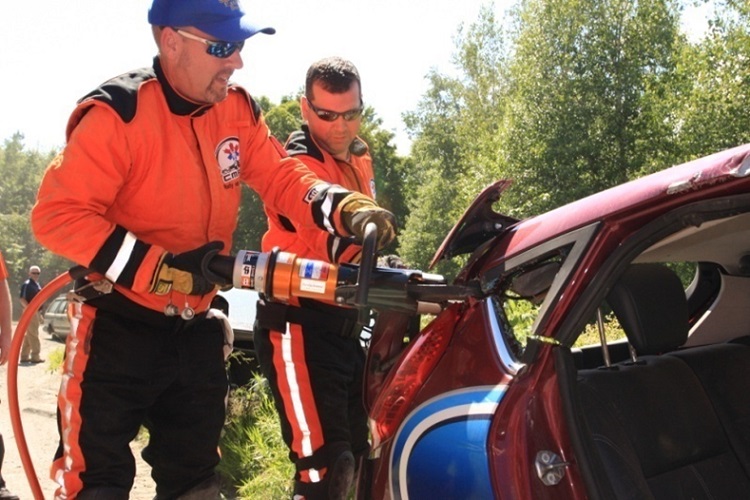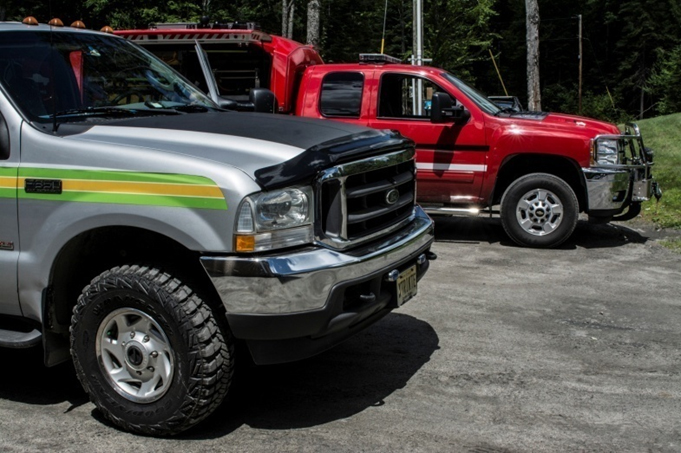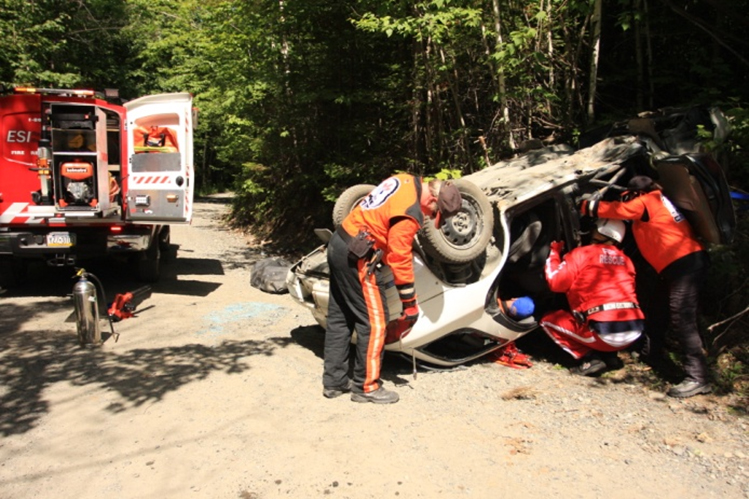

Photos courtesy of author.
By David Dalrymple
For Part 1 of this article, click HERE
The practical sessions of the program kicked off with a review of safety items, guides, and rules to be followed. The four practical stations—in a rotation—would be THE FOLLOWING:
- Patient packaging and removal,
- firematic evolutions,
- rescue tool evolutions, and
- scene stabilization.
At the patient packaging station, the students used a variety of devices to remove a driver from the seat and vehicle, which included a carbon fiber spoon device developed by the Canadian Motorsports Rescue Team, A Ferno XT device, a Speedboard device, and a Kendrick Extrication Device. Training also include helmet and head and neck restraint device removal.
The firematic station saw the students on board using extinguishers with wetting agents and a backpack compressed air foam system (CAFS) extinguisher. Besides simple vehicle compartment fires, a fully-involved rally car fire was extinguished using only the backpack unit.
Next, the students picked up a variety of power hydraulic rescue tools including next-generation battery-powered self contained tools and attacked two were older rally cars—an Audi and a Subaru —at the rescue tool evolution station. However, the rest of the vehicles were damaged Fiesta school cars. Why the difference? Because we wanted the students to experience the difference between “older” (less than 10 years) vs. “newer” vehicles (less than four years) to learn how the difference translates when using rescue tools.

And learn they did! The students found the older vehicle’s segments of little challenge, including the vehicles’ safety cages. The students did find that the self-contained battery-powered tool not only did the job well but was quiet and easy to maneuver regardless of the space. However, the students became a little flustered when working on the Fiestas, whose roof pillar/posts did not cut easily and made the cutting tools move and twist as they attempted each cut. They observed that the post/pillar appeared to be fairly small and easily fit into the space between the blades, but it did not serve readily. They also used the crash recovery software to see if there was a location where there was no ultra-high-strength steels (UHSSs) material; unfortunately, the Fiesta’s profile showed that both the A (1st) post/pillar and the B (2nd) posts/pillars had UHSS materials.
Another problem was that the Fiesta’s safety cage also ran along the A post/pillar, and none of the powered hydraulic rescue tools could reach and grab both roof post and safety cage tubing in one bite. The only tool that could accomplish this was the reciprocating saw with the specialty rescue blades. However, the blades wore out rapidly. The other lesson we want to impress on the students at this station was to show that using a power hydraulic ram increased and widened interior spaces using the ram’s ability to be pushed in a straight line with a significant force.

The last practical station was scene stabilization. Although most responders would consider stabilizing and securing the vehicle (which we did here), we also worked on mitigating every hazard we can find at an incident. The group used a new type of lifting cushion that was designed to “right” a vehicle that was on its side under complete control—an excellent piece of kit. The other piece of new gear we used was a special set of self contained stabilization struts. Easily deployable and lightweight, all components of the device are carried on it. This seemed like the perfect tool for shoring up a vehicle in precarious position out on a rally track.
The program’s final module was the practical incident scenario. The rest of the program was built on these scenarios as well were designed to fit all together and give the students the skills, ability, confidence, and knowledge to successfully deploy, size up, manage, and mitigate whatever scenario they encountered. For this section’s scenario, we used an older Subaru WRX to simulate a single-vehicle incident.
RELATED: The Battalion TV: Fresno Fire Vehicle Extrication ‖ Training Minutes: Victim’s Arm Pinned Under Vehicle ‖ Extrication Minutes: Fender Removal
The Subaru had gone wide, struck a tree, and rolled over. The co-driver was shook up, but he was basically uninjured. However, the driver was semi-conscious, had an altered mental status, and was hanging upside-down in his seat. Our co-driver then self exited, displayed the Red Cross, and flagged down the next car. The radio net was contacted, and the stage captain shut down the stage.
Now that the stage was closed to race traffic, the emergency services vehicles were then deployed to find and successfully mitigate the incident. The students then used a demo rapid response unit, which had an onboard CAFS from ESI Equipment and RoadwayRescue’s motorsports rescue unit, which doubles as a rescue tender for vehicle and motorsports rescue classes.

The instructors became the incident assessors and safety officers for this scenario. A modified set of assessor guides from the World Rescue Organization were used to evaluate the incident. On arrival, the group handed out various tasks to begin the mitigation process and establish incident command. As the incident progressed, the vehicle was secured from various hazards including vehicle stabilization. Since the co-driver’s door was open, the medic easily accessed the driver and began patient management.
Because the driver had an altered mental status, the medic flagged the patient as “red” (critical). An aeromedical asset was requested for deployment to the rescue crew that the driver needed an immediate release. Altohugh packaging began through the co-driver’s side, the doors on the driver’s side were removed to facilitate better access and final disentanglement of the driver and to transfer him to the ambulance.
One of the students maintained fire protection using a foam air pressurized water (APW) extinguisher then the backpack CAFS unit. Documentation was provided throughout the scenario; on completion of the exercise, all materials were stipulated to be handed over to the investivegative bodies. Also on completion of the exercise, emergency medical services provided rehab capabilities to the students (we had a basic life support ambulance on site as a standby). To wrap up the exercise, we secured all equipment and rolled the vehicle back onto its wheels for removal and proceeded to a final program review. The scenario took a little more than 14 minutes, from the initial report to the driver being taken to the simulated helicopter landing zone.

We then had the students review the entire program, starting with a question-and-answer session. The instructors then gave a review of student performances, from classroom interaction to an overview of the hands-on session to a critique of the scenario.
Last, we asked all students to give a critique of our roles and actions as instructors, the program, a guide to further performance goals we could add to the program, and what students themselves saw as the goals that were and were not met. Based on this postexercise information, following are the “lessons learned” from the initial delivery of the Emergency Services Rally School (ESRS) program:
- The students approved of the balance between classroom and practical training.
- The students felt the information delivered by Travis Hendon, Team O’Neil’s lead instructor, on “how to rally” events was extremely informative and gave great insight.
- Firematic practical sessions greatly helped the students, but it especially aided the medical providers, who had never touched either a foam APU extinguisher or anything larger, let alone extinguish any live fire. The students who were also fire/rescue providers liked the access to the cutting-edge equipment and extinguishing agents.
- The students, including all members of the Team O’Neil staff, were surprised at the vehicle space-making/creation station. One of the largest surprises was the strength of the Fiesta’s roof post/pillars and how they were difficult to sever with the power hydraulic rescue tools. Especially the difference between cutting the vehicle’s safety cage and those roof posts. Also of concerns was students’ inability to sever both the roof post/pillar and the underlining safety cage, not only because of the tools’ strength but their reach as well. Compared to the older vehicles, which were easily cut (the exception being the Subaru’s B post/pillar, which was also difficult depending on where the cut was made).
- Patient management and packaging was extremely difficult—regardless of the packaging device—with a secured, belted upside down driver! The medic was grateful that we allowed our “driver” to not wear a helmet and head and neck restraint device; it was extremely hot that day (about 95°F-plus). The students agreed that had never been encountered, so it was difficult to manage, but they appreciated the opportunity to practice it in a nonemergency setting.
- The interactive hand-on session was something no student had encountered before as a structured setting. The exercise gave the students more insight into all facets of the program. The students also felt more secure about the information presented in the classroom and the hands-on session regarding the equipment, the vehicles, and the rally prior to the exercises.
 We have taken the insights of our students and placed those thoughts into the next delivery of our program. Students can now ride in the cars as a co-driver on a simulated stage with one of Team O’Neil’s driving instructors. We have also developed an additional practical scenario where the students now have two incidents to mitigate, and students can swap roles. We may also add other current vehicles of different manufactures to our mix for practical sessions.
We have taken the insights of our students and placed those thoughts into the next delivery of our program. Students can now ride in the cars as a co-driver on a simulated stage with one of Team O’Neil’s driving instructors. We have also developed an additional practical scenario where the students now have two incidents to mitigate, and students can swap roles. We may also add other current vehicles of different manufactures to our mix for practical sessions.
Our team feels it has met our primary goal of delivering a high-speed, high-performance educational program in a real-world setting and environment. From their arrival until the end of each day, our students ate, drank, and learned in an environment that was totally immersed in rally. Although each student worked on their particular specialty, we also gave them the tools to see and work in other roles and responsibilities. From the student evaluations to their performances, we feel we are making the rally wold safer, one person at a time.
The 2017 ESRS program will run at the Team O’Neil Rally School in Dalton, New Hampshire from September 8 to 10 .
DAVID DALRYMPLE is a career EMS provider for the RWJUH Emergency Medical Services in New Brunswick, New Jersey, and a volunteer firefighter/EMT/rescue technician for Clinton (NJ) EMS/Rescue. He has been actively involved with emergency services for 30 years. He is the education chair of the Transportation Emergency Rescue Committee-US (TERC), is a certified international level extrication assessor, and serves on the Expert Technical Advisory Board of the IETRI as their road traffic accident advisor. Certified as a NJ fire service instructor, he has been teaching transportation rescue topics for more than 16 years. He is the executive educator for Roadway Rescue LLC, an educational team for transportation rescue training. He is an ICET (Netherlands) certified registered International SAVER instructor. He writes on “Extrication Tactics” for Fire Engineering and contributed to Fire Engineering‘s Handbook for Firefighter I and II (2009). He received the 2007 Harvey Grant award for excellence in rescue education. He is featured in “Training Minutes” on vehicle extrication on fireengineering.com.

